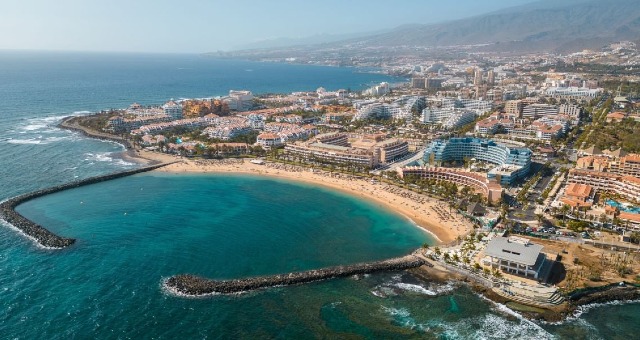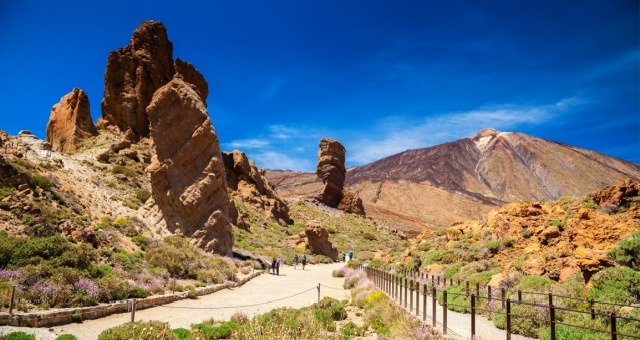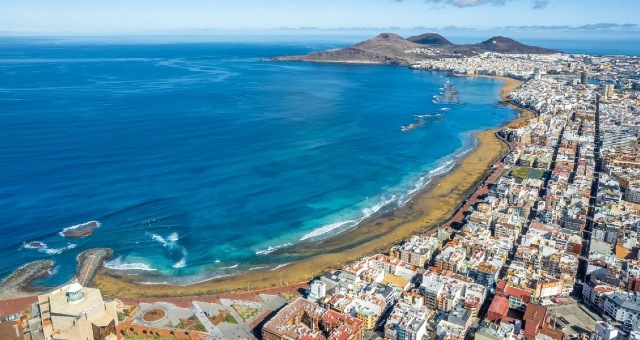Canary Islands itinerary: what to see in 7 days
5 stunning islands in 1 week!A paradise of golden sunshine, black-sand beaches, and stunning volcanic landscapes lies in the Atlantic Ocean, just off Africa’s northwestern coast, but belongs to Spain… Yes, you guessed correctly: it’s the Canary Islands! 8 major and many more smaller islands and islets comprise an archipelago that promises a delightful mix of adventure and relaxation, perfect for a week-long getaway that will create long-lasting memories.
This itinerary will take you from the cosmopolitan capital of Las Palmas in Gran Canaria to the unspoiled haven of Los Lobos. Let’s dive into a week of unforgettable discoveries! Keep reading to get the full picture and plan your Canary Islands escape on Ferryhopper with ease!

The stunning lighthouse on the beach of Maspalomas in Gran Canaria
Why visit the Canary Islands
The Canary Islands offer numerous reasons to visit, beginning with a trait that has earned them a reputation as “the sunshine center of Europe”: their famously mild, year-round climate, which makes every season feel like spring. Beyond the pleasant weather, travelers can enjoy an impressive variety of activities, from hiking across diverse trails and diving into water sports to simply relaxing at some of the most exquisite beaches in the world.
Nature enthusiasts cannot help but fall in love with their landscapes, as the islands’ volcanic origins have dramatically shaped them with rugged mountains, eerie craters, and otherworldly rock formations that make exploration unforgettable. Adding to their allure, the Canaries boast a rich cultural and historical heritage evident in their traditional fishing villages, colourful old towns, and archaeological sites.
And with ferry connections from Spain’s mainland ports as well as frequent and reliable ferry crossings between all the islands throughout the year, a 7-day itinerary gives you plenty of time to get a good taste of the Canaries’ unique offerings.
How to get to the Canary Islands
You can reach the Canary Islands either by ferry from mainland Spain or by plane. Ferries to the Canary Islands in 2026 from mainland Spain depart from the ports of Cádiz and Huelva. Although the average trip duration is on the long side, a ferry ride to the Canaries gives you the opportunity to admire the Atlantic Ocean while also allowing you to travel with your pet and/or your vehicle.
Here are some of the most popular ferry routes from mainland Spain to the Canary Islands:
However, when time is of the essence, the fastest way to get to the Canary Islands is by plane. Some of the most popular airports in the Canaries, serving both domestic and international flights, are Gran Canaria Airport, Los Rodeos Tenerife North Airport, and Reina Sofia Tenerife South Airport in Tenerife, as well as Lanzarote Airport.
Detailed 7-day itinerary for the Canary Islands
Our 7-day Canary Islands itinerary takes you across some of the archipelago’s most stunning landscapes: from volcanic peaks and golden dunes to lush forests and crystal-clear beaches. Blending island-hopping adventures with relaxing stops and scenic hiking routes, it is tailored to travelers who wish to immerse themselves in the diverse beauty of the Canaries.
Day 1: arrive in Tenerife
Welcome to Tenerife, the largest of the Canary Islands! You can choose between two points of arrival, Santa Cruz de Tenerife or Los Cristianos, as both serve as excellent starting points for your itinerary across the Canaries.
Santa Cruz de Tenerife, the island’s capital in its northeastern part, is one of the archipelago’s most developed cities, a cosmopolitan hub bustling with energy, sights, historic plazas like Plaza de España, and colourful markets like the Mercado de Nuestra Señora de África where you will find everything from local produce to traditional crafts as you immerse yourself in an authentic Canarian atmosphere. If you cannot wait to hit the beach, Playa de Las Teresitas, a family-friendly beach with white sand and palm trees, awaits you just 15 minutes from the city center.
If you opt for Los Cristianos on the island’s southwest coast, you are in for a picturesque seaside resort, less touristy than Santa Cruz but still lively and conveniently close to many points of interest. Once you settle in, you can head to Playa de Los Cristianos for a swim in its calm waters, followed by a stroll through the town center, which has many pedestrian streets. Or, you can hop on a boat from the port to spot dolphins and whales off the coast, a maritime experience to be cherished.
Either you choose Santa Cruz or Los Cristianos, make sure to get some good rest at night because the next day you are in for a volcanic treat…

The vibrant resort town of Los Crisitanos in Tenerife
Day 2: explore Tenerife’s Teide National Park
Rise and shine because the second day of your Canary Islands itinerary will be dedicated to Tenerife’s crown jewel: Teide National Park, home to Mount Teide, which is Spain’s highest peak. Black lava fields, caves, and otherworldly rock formations adorn the scenery of this UNESCO World Heritage Site, located at the center of Tenerife and considered one of Europe’s most visited national parks. Take your time to take it all in, ride the cable car to the summit to witness dramatic views, or follow one of the many hiking routes.
On your way back to Los Cristianos, make a stop at the nearby historic town of La Orotava, where you can admire many examples of traditional Canarian architecture, and cap your day of exploration by trying the local cuisine.

Breathtaking rock formations in Teide National Park
Day 3: take a day trip to La Gomera
Time for the next stop on your Canary Islands itinerary: a day trip from Tenerife to La Gomera! Book an early ferry from the port of Los Cristianos and, in just 50 minutes, San Sebastián de La Gomera, the island’s capital and main port, will welcome you with its colourful hillside houses. You’ll find rich history here: a statue of Christopher Columbus and the medieval Torre del Conde (Tower of the Count) hint at the island’s past. Linger a while at the open market on Avenida de Colón for local delicacies, and then step through the door of the Church of the Assumption to admire a painting dedicated to historic old battles that is on display.
Next, nature calls: the lush Garajonay National Park, another UNESCO World Heritage site, with its ancient laurel forests and moss-covered trails. With plenty of hiking options, you’ll have the chance to experience first-hand the tranquil charm that makes La Gomera known as “the magical island”.
On your return to San Sebastián, you can make a stop in quaint villages like Hermigua and El Cedro. The former rests in the middle of a ravine surrounded by banana plantations, while the latter is famous for its watercress soup, which feels like a taste of heaven after a 3-hour hike!
If you decide to skip the trails for a place under the sun, the volcanic-sand beach of Playa del Inglés is a legendary, unspoiled spot, favoured by modern-day “hippies” and nudists. If this isn't your scene exactly, the beach near San Sebastián is also a good choice for soaking up the Atlantic waves and taking in the serene surroundings.
We know that you probably won’t want to say goodbye to La Gomera so fast… However, as this is the ultimate 7-day itinerary to get the most out of the Canaries, you need to plan your return to Los Cristianos in Tenerife accordingly to ensure you have time to catch a bus or make the 50-minute drive to Santa Cruz. Once there, it is time to get some well-deserved rest before the next chapter of your Canarian adventure begins.

The colourful town of San Sebastian de La Gomera
Day 4: arrive in Gran Canaria
Next stop: Gran Canaria! The trip from Santa Cruz de Tenerife to Las Palmas, the capital of Gran Canaria, is the most popular ferry route in the region as it connects the archipelago’s two capital cities. In approximately 1 hour and 40 minutes, you will arrive at the city’s port, located about 5 km from the centre, but very close to Las Canteras, which is considered one of the best urban beaches in the world, where you can stop for a refreshing dip.
Next, all roads lead to Vegueta, the old quarter of Las Palmas, which features some of the most striking examples of colonial architecture, like the Casa de Colón that operates as a museum dedicated to the history of Las Palmas, the famous Plaza Santa Ana and its equally renowned Cathedral, as well as colourful food and flea markets that are set up daily.
As dusk begins to fall, head to the Triana district, known for its long pedestrian street, modernist architecture, and numerous options for a delicious dinner or a drink among the locals.

The long, urban beach of Las Canteras in Las Palmas
Day 5: go south for a hearty dose of sun and sea
A visit to Gran Canaria, however brief, is not complete without witnessing the Maspalomas Dunes. To reach Maspalomas from Las Palmas, you can either rent a vehicle and be there in about 45 minutes or take a bus, which takes roughly 1 hour and 15 minutes and allows you to admire the island’s coast along the ride.
Maspalomas Dunes is a vast natural reserve that feels like a desert just a few steps from the sea. Have your phone charged because you will want to take lots of photos of this breathtaking scenery, which is one of the main reasons why Gran Canaria is dubbed “the miniature continent”. Then, follow the golden sands down to Maspalomas Beach for a dip or climb the Maspalomas Lighthouse (El Faro) for panoramic views of the coastline.
In the afternoon, take the coastal road west to Puerto de Mogán, a charming fishing village affectionately called “Little Venice.” Spend some time wandering through its colourful alleys, browsing small shops, or enjoying a peaceful walk by the marina.
Day 6: say “hola!” to Fuerteventura
All good things must come to an end… but your Canary Islands island-hopping itinerary is not over yet! Your next and last stop is Fuerteventura, the archipelago’s fourth largest island. In about 2 hours, you will have waved bye-bye to Las Palmas to find yourself at Puerto del Rosario, the island’s capital and cultural centre.
After you have some well-deserved rest, head northwest to Popcorn Beach (Playa del Bajo de la Burra), one of the most Instagrammable and, dare we say, cinematic beaches in the Canaries, as it is covered with white algae fossils that look like the beloved movie snack! Just remember: do not be tempted to take some of them with you as a souvenir, as their removal is strictly prohibited!
If the sight of popcorn, even if not real, makes you hungry, continue to El Cotillo, a laid-back fishing village, for a lunch of fresh grilled fish with papas arrugadas (small potatoes cooked with saltwater) served with mojo picón (a traditional spicy sauce).

The amazing turquoise waters of Corralejo beach in Fuerteventura
Day 7: day trip to Los Lobos
The last day of any travel itinerary is always the hardest, we know! If you want to spend the remainder of your time in the Canaries just exploring Puerto del Rosario in search of souvenirs and local goodies to take home, visit the open-air sculpture park scattered around the city, or just hit the beach (we recommend the Blue Flag-awarded Playa Blanca), then this is definitely time well spent.
However, if you have plenty of time before your scheduled departure, consider a day trip to Los Lobos, a largely uninhabited island off the coast of Fuerteventura. To get to this idyllic piece of land, you need to drive or take a bus from Puerto del Rosario to the town of Corralejo. The drive takes approximately 30 minutes, and from Corralejo, you can take a 15-minute boat ride to arrive at Los Lobos. Local companies operate boat rides in Fuerteventura, so we recommend contacting the operator of your choice to book your day trip to Los Lobos.
Once you disembark, you will find yourself in a pristine, car-free environment, where one of the main highlights is the crescent-shaped, white-sand bay of Playa de la Concha. Nearby, at Puertito de Lobos, there’s a rustic wooden platform ideal for diving into crystal-clear waters, and the underwater world surrounding the islet is also perfect for snorkelling.
For those who want a little adventure, the hike up to the volcano cone of La Caldera offers sweeping panoramas across to Fuerteventura and even to the island of Lanzarote in the distance. You’ll also pass the lighthouse Punta Martiño, a classic viewpoint and reminder of the island’s rugged nature.
Travel tips for your Canary Islands itinerary
Here are some useful travel tips to help you plan a smooth and hassle-free 7-day itinerary across the Canary Islands:
- Best time to visit: the Canary Islands have a reputation for year-round mild weather, but spring and autumn are preferable in terms of ideal temperatures and fewer crowds. Find out more about the climate of the Canary Islands on Ferryhopper.
- Getting around: the best way to explore the islands at your own pace is by renting a car. However, most points of interest mentioned in this guide are connected by frequent bus services.
- What to pack: your travel bag should absolutely contain sunscreen, one or more bathing suits, a light jacket for the mountainous areas and the nighttime temperatures, which tend to be a bit cooler, and comfortable shoes for walking and hiking.
- Local food to try: papas arrugadas con mojo (“wrinkled” potatoes boiled in salt water with spicy red or garlic-herb green sauce), ropa vieja canaria (stew made with shredded beef or chicken, chickpeas, potatoes, and spices), pulpo a la gallega (Canarian-style octopus), frangollo (traditional pudding), quesillo (caramel flan), and local wines from volcanic vineyards.
Book your Canary Islands ferry trips with Ferryhopper
Now that you can picture what a 7-day itinerary in the Canary Islands looks like, it is only fair to want to experience it firsthand. Your next steps? Check out our Map of ferries for all routes, prices, and schedules, and book your tickets on Ferryhopper with no hidden fees.